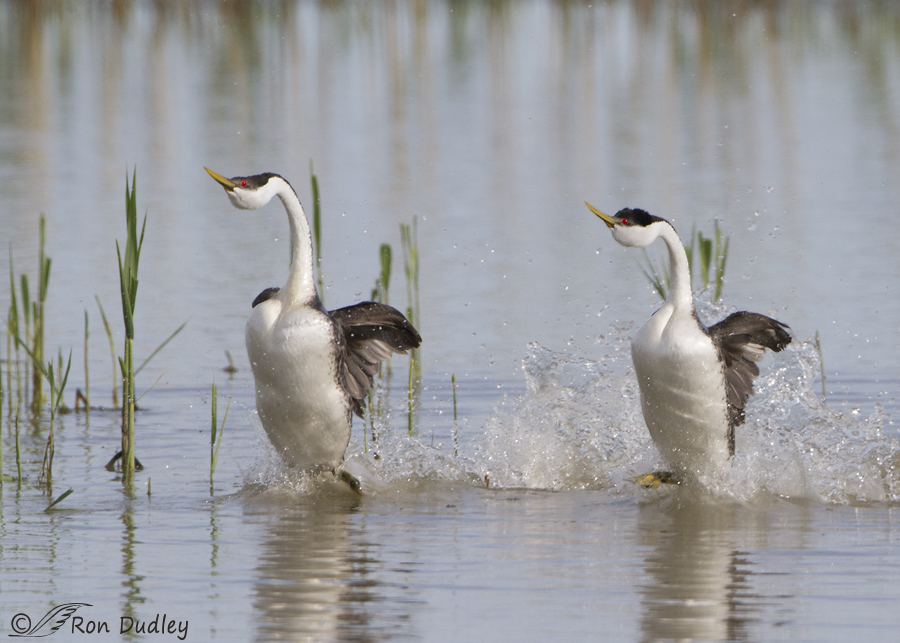I’ve found the rushing behavior of Western Grebes to be one of the more difficult bird photography challenges of all. First of all you have to be there when it happens and I’ve only seen it a handful of times. Since it usually (though not always) involves two birds you also have the problem of getting both of them in frame and in focus during a behavior that is incredibly fast and difficult to anticipate. Ideally the two grebes should be relatively close to each other but well separated. And even if all that falls into place the images can be ruined by a busy, cluttered or unattractive setting. It isn’t easy…

1/2500, f/7.1, ISO 500, Canon 7D, Canon EF500mm f/4L IS USM +1.4 tc, not baited, set up or called in
For those unfamiliar with the behavior, rushing is part of a complex courtship that helps to establish pair bonds. The birds lunge forward out of the water and run across the surface in a highly choreographed “dance” with a unique posture. Their wings are lifted but not extended (remiges or flight feathers remain folded) and they do not flap. They run 15 – 60 feet across the water without vocalizing but the pattering sound from their churning feet is distinctive and loud. Rushing concludes when both birds, still at speed, dive headfirst into the water.
This image was taken just over two years ago at Bear River Migratory Bird Refuge and was my best opportunity to photograph the behavior. If you haven’t seen grebes rushing before or would like to again here’s links to a couple of video clips – clip # 1 and clip #2. Enjoy.
Ron


Absolutely love this shot!
I have never seen this before so I will check out the clips you posted. This is such a great photo. They are both in identical positions. I have been introduced to so many amazing birds and bird behaviors because of your photos. Thanks so much Ron!
I love that you are rewarded with such magnificent sights – all your patience, dedication and scholarship. I so appreciate your photos and the video clips! Awe-inspiring… Thanks!
I’m delighted that you enjoyed the post, Alison. Thank you.
Wowzer, Ron!!!!! Well done, kiddo!!!!! ( patting you on the back and handing you a cold one )
: ))
Wow, handing me a cold one and calling me “kiddo” at my age – you’re batting 1000 in my book, Lois! Thanks.
Thanks Ron. GREAT!!!!
Thank you, Karen.
Loved this – and Patty’s gem of a comment.
Perhaps they were displaying for me ‘down under’.
Great turn-around on Patty’s comment, Elephant’s Child. Thank you.
Being in the right place at the right time is one thing. Capturing a brilliant image of both birds displaying the behavior is something special!
Thank you for sharing this moment!
Thanks very much, Wally. Sure hope you enjoyed your recent trip.
I’m really glad I watched both clips – seeing the foot action in the second one was a lot of fun. The videos also make it clear why this image you posted was so hard to get. That’s quite an amazing behavior routine.
I enjoyed watching those clips too, Susan. It was almost like seeing the behavior in the flesh again except for the background music and the lack of sound from the pattering feet. Thank you.
Is the one on the right male? I wonder because of the slightly raised crest.
Arwen, The bird on the right is a female. Though the sexes are similar, females are smaller and their bills have a slight upturn.
Thank you, sir.
Like everything about this interesting capture of behavior…the birds themselves, the action, the reeds, the water’s surface, the splash, the comments…even the fact that they have their heads on upside down. This is very likely as close as I’ll ever get to seeing such amazing behaviour….Thanks!!!
“even the fact that they have their heads on upside down”
Ha, that made me laugh, Patty. Thanks.
Wow! This is amazing, Ron!
Thank you, Gail. To witness the behavior in person is an unforgettable experience.